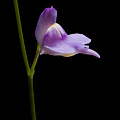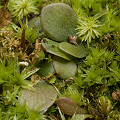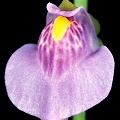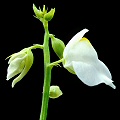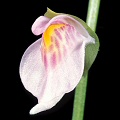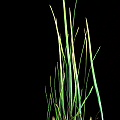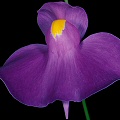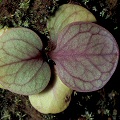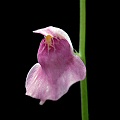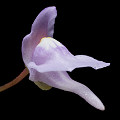| Utricularia section Foliosa | ||
|---|---|---|
| Species | Range | Habit1 |
| U. amethystina | USA, Latin America | T |
| U. calycifida2 | South America | T |
| U. hintonii2 | Mexico | T? |
| U. hispida2 | Latin America | T |
| U. huntii2 | Brazil | T |
| U. longifolia2 | Brazil | T |
| U. panamensis2 | Panama | T |
| U. petersoniae2 | Mexico | T/L |
| U. praelonga2 | South America | T |
| U. regia2 | Mexico | T |
| U. schultesii2 | Colombia, Venezuela | T |
| U. tricolor | South America | T |
| U. tridentata | South America | T |
|
1T=terrestrial; L=lithophyte. 2Formerly in section Psyllosperma. |
||
Q: About Utricularia subgenus Utricularia section Foliosa
A: The current interpretation of this section consists of species that Taylor had
relegated to two separate sections. However, research in
2006 indicated that the two sections were not monophyletic; in other words they should be reshuffled and in this case combining
them made the most sense. This section is generally delineated by a number of minor characters. From a nontechnical
perspective, most of these plants have relatively large leaves.
Utricularia amethystina
This pretty little purple flowered species once occurred in two counties in
peninsular Florida (Lee, Collier counties). Unfortunately it has not been seen in Florida for many years, and I suspect it has been
wiped out in the USA. While it still can be found in Latin America, it is noteworthy as the first species to be
wiped out within USA borders.
Utricularia calycifida
I have a particular fondness for this species, as it is one of the few species
that can have particularly beautiful leaves (with purple venation). I have put a great deal of effort into hybridizing clones,
and over the years I named several cultivars. These are plants with names derived from horror stories by dear old H.P. Lovecraft.
The cultivars are U. 'Asenath Waite', U. 'Cthulhu',
U. 'Lavinia Whateley', U. 'Mrs. Marsh', and
U. 'Yog-Sothoth'. Probably the finest from this group is U. 'Asenath Waite'.
Utricularia longifolia
Quite probably one of the most commonly grown species, this plant
can have the longest leaves (although not largest in surface area) in the genus. When it flowers, stand back and be ready to
be astounded. A few odd clones occur in cultivation, namely a short-leaved plant, a white flowered form, and a plant referred to
as Utricularia longifolia var. forgetiana. I have grown this, and have not
seen any significant differences between it and the many other clones in cultivation, except that its flowers were a bit
smaller than those on the other plants. Not a trait I consider very worthwhile!
Utricularia praelonga
This plant confounded me when I first grew it, because although it produced
little obovate leaves, my pot of it was infested with a kind of grass that made long, erect leaves. I kept pulling these out
until the day I realized that these were leaves of the same species! Yes, it makes two kinds of leaves! It is really hard to
convince this plant to flower.
Utricularia regia
Similar to U. hintonii and
U. petersoniae, but with the upper corolla lip divided into two linear-spatulate lobes, each of which
is divided again, for four lobes total.
Utricularia tricolor
This species has nice little fan-shaped or kidney-shaped leaves. I have never
had success convincing it to flower. Oh, it is easy enough to obtain inflorescences. But they always abort. Very annoying.
Utricularia tridentata
Another pretty, and easily grown species that has light colored flowers that
add a bit of pleasure to a terrarium. Like the others in this group of species, this is invasive in carnivorous plant terraria
or greenhouses, so be careful about where you put it.
Page citations: Müller et al. 2006;
Rice, B.A. 2006a; Taylor, P. 1989; Zamudio & Olvera 2009; personal observations.
